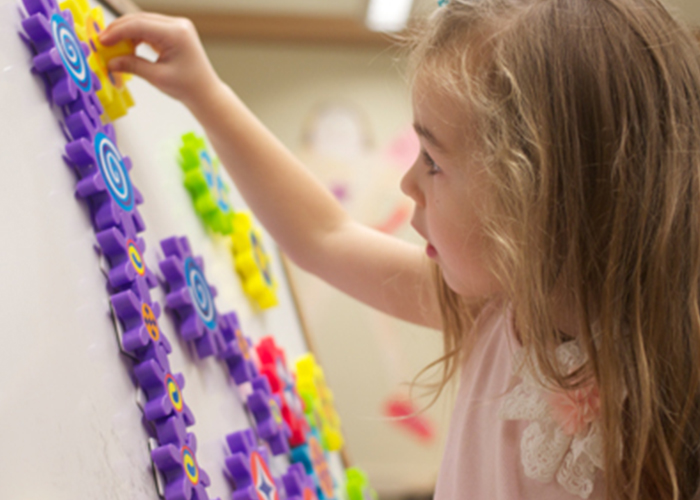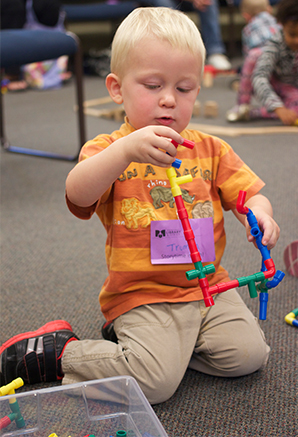Science
Children have a natural curiosity and love to explore the world around them. This is science! You can foster your child’s science skills by encouraging questions, observing, talking about possible answers together, and then encouraging a “hands-on” approach to learning. Allowing children to experiment and try new things strengthens their science skills to help them get ready for kindergarten. Try some of these easy activities with your child.
Activities to try at home
Science experiences with water
Water and oil
Shadows
Explore outside
Ramps
Science experiences with water
Activity 1: Measurements
Fill a large bowl or storage container with water. Place the bowl outside on grass or another area with good drainage like a patio. In winter months and for those without outdoor space, this activity can be done over a sink, bathtub, or with bowl on a towel.
Provide your child with a variety of kitchen tools, such as measuring spoons and cups, small bowls, cups, turkey baster and so forth.
Encourage your child to use the various tools to learn more about the properties of water and simple concepts of measurement. Ask your child questions as he or she explores, such as, “Which cup holds the most water?” and “How many cups of water do you need to fill the bowl?”
Activity 2: Ice
Ice is a fun sensory activity for children. Let your child help you fill an ice cube tray with water and put it in the freezer. After the water has frozen, take the ice cubes out and put them in a bowl. Let your child touch and explore the ice cubes. Talk about how the ice is the same as and different from water. You can also provide cups, spoons, etc., for additional exploration with ice.
Activity 3: Ice plus
With a little help your child can perform simple ice experiments. Gather together the following household items: muffin tin, hot water, cold water, salt, sugar, six ice cubes, and a towel.
Using a muffin tin, place one ice cube in each compartment. Show your child the other items you gathered and ask what he or she thinks will happen to the ice when you add each item individually to one of the compartments. Ask your child to predict which ice will melt the fastest and why he or she thinks that. Also ask which will take the longest time to melt. Finally, ask what would happen to an ice cube if your child held it.
After discussing the predictions, help your child add hot water to one compartment, add cold water to another compartment, sprinkle a generous amount of salt on the ice in another compartment, and sprinkle table sugar on the fourth ice cube. Do not add anything to the fifth ice cube. Have your child pick up the sixth ice cube and hold it over a towel or the sixth compartment.
While you and your child watch the ice, talk about what is happening to the ice cubes. Did the predictions turn out to be correct? Talk about why or why not the predictions were accurate.
You can also use a timer and record how long it takes for each ice cube to melt. You can write down the time for each and talk about which ice cube melted the fastest and slowest according to the numbers you wrote down.
Water and oil
Do an experiment with water and oil! Fill a clear drinking glass about 2/3 full of water. Add a layer of cooking or mineral oil. Add a few drops of food coloring to another glass of water. Use an eye dropper to drop the colored water onto the oil. Observe what happens. Water is heavier than oil, so the water drop falls through the oil.
Shadows
Have some fun with shadows! On a bright, sunny day head outside with your child. Have them stand on a sidewalk or driveway. With sidewalk chalk, first trace around their feet and then, while they are holding still, trace around their shadow. Write down the time next to their shadow. A few hours later have your child stand in the same place and observe their shadow. How is it different from earlier in the day? Trace around this shadow and note the time. Do this several times throughout the day. Discuss with your child what makes shadows (the position of the sun). You may also have your child trace your shadow throughout the day.
Explore outside
Go outside and explore! Take a nature walk with your child and let them take the lead. When they want to stop and look at something, stop with your child and look too. Ask them questions about what they see, hear, and touch. What colors are in this? What animal do you think made these footprints? This can be a fun activity any season of the year.
Ramps
On your mark! Get set! Go! Make a ramp out of whatever materials you have such as a cardboard tube, box, board, piece of cardboard, or any flat surface that you can incline against a chair or wall. Now start experimenting with different objects! Balls (different sizes), toy cars, toy trains, pom-poms, cans from the pantry, blocks, or whatever your child wants to send down the ramp. Talk about which things go faster or slower and which things roll the farthest. Try changing the incline of the ramp. Does this change how fast and how far the objects go?
Further exploration and more activities:
Christmas Science: An Oil and Water Experiment
K is for Kinetic Energy


